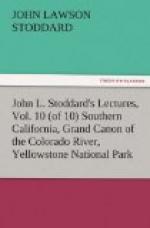“How do you obtain it?” I asked.
“We buy the requisite amount of water with our land,” was the reply. “Do you see that little pipe,” he added, pointing to an orange grove, “and do you notice the furrows between the trees? Once in so often the water must be turned on there; and, as the land is sloping, the precious liquid gradually fills the trenches and finds its way to the roots of the trees.”
[Illustration: A Raisin ranch.]
Dealers in California wines declare that people ought to use them in preference to the imported vintage of Europe, and the warehouses they have built prove the sincerity of their conviction. One storehouse in the San Gabriel Valley is as large as the City Hall of New York, and contains wooden receptacles for wine rivaling in size the great tun of Heidelberg. We walked between its endless rows of hogsheads, filled with wine; and, finally, in the sample-room were invited to try in turn the claret, burgundy, sherry, port, and brandy.
[Illustration: An orange grove, Pasadena.]
[Illustration: A California Vineyard.]
“How much wine do you make?” I asked the gentleman in charge.
“In one year,” was the reply, “we made a million gallons.”
I thought of the Los Angeles River which I had crossed that morning, and of its sandy bed one hundred feet in width, with a current in the centre hardly larger than the stream from a hose-pipe, and remarked, “Surely, in some portions of this land there is more wine than water.” “Where do you sell it?” I presently inquired.
“Everywhere,” was the answer, “even in France; and what goes over there you subsequently buy, at double the price, for real French wine.”
[Illustration: At the base of the mountains.]
It was the old story, and I doubt not there is truth in it; but the products of California vineyards, owing, possibly, to the very richness of the soil, do not seem to me to possess a flavor equal in delicacy to that of the best imported wines. This will, however, be remedied in time, and in the comparatively near future this may become the great wine-market of the world. Certainly no State in the Union has a climate better adapted to vine-growing, and there are now within its borders no less than sixty million vines, which yield grapes and raisins of the finest quality.




